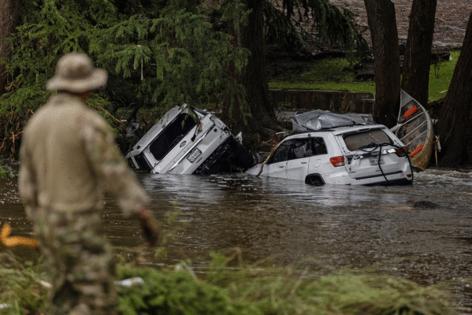Mark Gongloff: The flash-flood era is here, and we're not ready
Published in Op Eds
New York City’s subway system is mainly known for moving millions of riders every day and scaring the U.S. transportation secretary. But every so often it also becomes the world’s least-popular water park.
Instagram was rife this week with unnerving videos of subway riders watching high waters churn outside their train cars after a brief but biblical downpour dumped more than 2 inches of rain in less than an hour on Monday, overwhelming the city’s drains and turning subway stations into raging rivers. What might have been a mundane summer rainstorm at one time led to flooding that killed at least two people, destroyed property and snarled travel across three states.
It’s becoming a grimly familiar story. In just the past two weeks, destructive and deadly flooding has occurred in Maryland, Virginia, North Carolina, Chicago, Iowa, Tampa, New Mexico and, of course, Texas.
Floods aren’t new, according to the the climate-change deniers in my inbox, but their frequency and severity have worsened as the planet has become hotter. It’s just physics: Warmer air can hold more water. So when those mundane summer rainstorms hit, they’re wetter, dumping more rain all at once. Hundred- and even thousand-year floods become almost routine. They’re even repeatedly hitting places like Vermont, which were once considered safe havens from climate change.
In fact, this sort of flash flooding might just be the new normal, if you can use such a term to describe the phase we’re experiencing as we transition to a future normal of even worse disasters after even more warming. Unfortunately, despite the obvious frequency of such events, most of this country is still not ready for it.
Two years ago, after yet another New York subway flood, I complained it was too easy for rain to bring the city to its knees. That hasn’t improved significantly in the interim, though Mayor Eric Adams has invested $1.2 billion in flood-resilient infrastructure such as storm-water management and flood sensors — much of which is still being installed.
The tragedy in Texas exposed how many places aren’t equipped to warn people about rising waters in time to save lives. At this point, every place where it rains is potentially at risk of flooding — meaning pretty much everywhere in the world, including Death Valley. People need to be aware of their individual flood risks and keep an eye on the weather, just in case their local authorities aren’t able to warn them.
And far more Americans need flood insurance. Though 99% of U.S. counties have experienced flooding in the past 30 years, only 4% of American homes are covered for floods, according to the Federal Emergency Management Agency. People lacking coverage in places like the North Carolina mountains after Hurricane Helene and Texas Hill Country on July 4 lost everything when their homes were washed away in an instant.
But typical homeowners’ insurance policies don’t include floods, and high-risk properties can’t always get separate flood coverage from private carriers. For them, it’s only available through the National Flood Insurance Program, which is managed by FEMA, which is currently managed by basically nobody. The current director, David Richardson, has been invisible during the Texas floods and has expressed befuddlement about things like the need for hurricane-season planning and how big Texas is.
Richardson’s boss, Homeland Security Secretary Kristi Noem, has joined her boss, President Donald Trump, in openly daydreaming about killing the agency. She fired call-center contractors responding to Texas flood victims and has otherwise slowed disaster response by requiring her personal sign-off on large purchases.
Trump, Noem and Elon Musk’s Department of Government Efficiency laid off 1,000 FEMA staffers ahead of hurricane season. They also ended FEMA’s Building Resilient Infrastructure and Communities program, which helped places like New York and Texas brace for future floods.
This is the opposite of how we should be moving in an era of supercharged rainstorms. First, we need to stop burning fossil fuels as quickly as we can. The hotter the planet gets, the worse these storms will get. Meanwhile, houses and offices need to be waterproofed along with our infrastructure. Many drainage systems were designed and built for a climate that no longer exists. They need to be upgraded to handle bigger water flows. The NFIP may survive Trump and Noem, but it needs to be overhauled and drastically expanded to include millions more homes than are on FEMA’s limited flood-zone maps.
Flash floods will always be terrifying, and it seems they’re here to stay. But there’s plenty we can do to make sure they’re not nearly so dangerous and destructive. When it’s flooding basically everywhere, politics shouldn’t stand in the way.
____
This column reflects the personal views of the author and does not necessarily reflect the opinion of the editorial board or Bloomberg LP and its owners.
Mark Gongloff is a Bloomberg Opinion editor and columnist covering climate change. He previously worked for Fortune.com, the Huffington Post and the Wall Street Journal.
©2025 Bloomberg L.P. Visit bloomberg.com/opinion. Distributed by Tribune Content Agency, LLC.

























































Comments